SONS
OF DEWITT COLONY TEXAS For more biographical information, Search Handbook of Texas Online From The Empresario by A.B.J. Hammett, 1973
This young, ambitious traveler, Don Martín De León, then and there decided that all of this beauty, and such an abundance of wild life, was a dream come true. Here was farm land, grazing pasture, grassland for horses and cattle, an abundance of it for himself, his children and his children's children. In his native country of Mexico, and in New Orleans there was indeed a good market for everything he could produce from this rich country. Since Don Martín De León, had an ardent love for hunting, this was also truly a paradise for a hunter. He could not believe it could be true. It was Martín's desire to create a permanent settlement and as a starter he accordingly petitioned the Spanish Governor of San Antonio in 1807, for land that was located between the Aransas River and Cheltipin Creek. Here he started a fine pasture consisting of many leagues of land, which he enclosed to contain the wild mustangs he had captured on the prairie and was domesticating. Martín De León's first petition for a colony was not granted by the Spanish Governor, but it did not discourage this strong hearted man of noble blood. He tried again and his application was rejected. With this rebuff, he then moved from the Aransas to the east bank of the Nueces River, where he started all over again, enclosing new leagues of pasture land, for his ever increasing herd of mustangs. This location was just below the present site of San Patricio. The Comanche, Lipan and other Indians became more hostile and intolerable day by day, creating a situation where Martín De León and his family were never safe for a moment. After many narrow escapes from death, by the Indians, the De León family finally made a fast move to San Antonio, for their protection. After living in San Antonio, for a while Don Martín De León joined and co-operated with the Republican movement against the Royal Power. The De León children were growing up, Fernando was born in 1798, Candelaria in 1800, Silvestre in 1802, Guadalupe in 1804, Felix in 1806 and Agapito in 1808. A decision was made to make a long, hard, treacherous trip to visit with their parents in Burgos, Tamaulipas and Cruillas, Mexico. So they decided to make the trip, children and all. The trip was successfully made and it was good to be back with their families and to visit with relatives and old friends. The visit, however, did not last long, Don Martín De León was restless and anxious to return to his Texas. It was now home to him and he constantly dreamed of a new colony and was anxious to get back and try again for authority to create his colony. Upon returning he spent much of his time looking after his cattle that now totaled about five or six thousand head. He also owned the finest and most handsome horses and his reputation was well known for all of these including his fine droves of mules, very much in demand. He sold horses, mules arid cattle every year at New Orleans, making handsome profits or these business transactions. His wagon trains would return from New Orleans, heavily loaded with supplies for his family, and his many helpers on his ranches. By this time his family had increased by Maria Jesus, born in 1810, Refugia in 1812, Augustina in 1814 and Francisca in 1818. New Orleans Trip Brings Success. Sometime in the year of 1822, Don Martín De León was in New Orleans. While on this trip he met a Carlos Lazo, aboard a pirate ship that was in the command of a Frenchman named Ramon La Fou. Don Martín De León worked out a deal with the French pirate and chartered his ship. Part of the bargain which included delivering supplies for Don Martín to his Texas Colony, was the promise by Don Martín that he would obtain a pardon from the Mexican government for the French pirate, La Fou. As soon as agreements had been made, every hand was busy loading Don Martín's valuable cargo and sail was set with a course to the mouth of the Rio Grande. After they arrived at Brazos de Santiago, near Matamoros, Don Martín arranged to go ashore for the purpose of negotiating the pardon for his pirate benefactor La Fou. He had to leave his son, Felix, aboard the pirate ship during his absence, as assurance of his good faith. Don Pedro Jose de la Garza, was the chief quartermaster at Padilla, which was the capital of the State. Through the influence of Don Martín's friends, Don Pedro and General Don Felix de la Garza, who was the commanding officer in Tamaulipas, the promised pardon was secured for his French pirate friend, La Fou. At this time, Don Martín De León, while being graciously received by his friends, decided it would be appropriate to ask his friends for permission to request the long desired and refused charter for the new colony in Texas. This time Don Martín's friends were favorable, receptive and enthusiastic. They warmly endorsed his petition for a grant and he was to be the Empresario of a colony in Texas. He received full authority in 1824, to occupy any vacant land he should choose for the forty one colonists he had named in his grant application. Don Martín De León's cherished dream of many years, was now a reality. He had the colonization grant, but he lacked the needed funds to carry out his plans. Within a short period of time, Madam De León's father, Jose Angel Garza died and left her nearly ten thousand dollars, some valuable cows, horses and mules. All of this was just what was needed to launch the new colony, and his wife, Dońa Patricia shared her husband's joy and enthusiasm in establishing the new colony in the wild country of Texas. Dońa Patricia was already accustomed to the hardships and the life to come. All of their children except Fernando, the oldest, were native born in Texas, and lived through the Indian raids and massacres that harassed them many years, when they lived and made their home along the banks of the Aransas. Those were indeed rough days to pioneer a new colony. Reports state that a Mexican by the name of Corasco with his servants was driving a Cabedella of mules through that area to Louisiana. After crossing the Colorado, they were attacked and all murdered, with the exception of one Mexican servant, who escaped to a settlement of the colonists, badly wounded. The robbers with their bounty proceeded towards Louisiana, and while crossing the Brazos, were overtaken and all were instantly killed. The head of one of the robbers was cut off and set on a pole as a warning to like offenders. These rugged people, the Texas pioneers, the De Leóns continued to fight the Indians, engaged in good work and they met and overcame the difficulties with manly firmness. Their luxury in those days were the beholdings of the loveliest natural scenes of nature, and in taking part in the stirring adventures of the time. The common dress of the men and children was buckskin, and sometimes the women were obliged to dress alike.
It is said while the Empresario and his sons were busy with the management of the affairs of the colonists, Madam De León managed the home on the ranch and in town with dignity, truly in the character of a woman of culture and good breeding. She transplanted the seed of culture and aristocracy of Spain, and old Mexico, into the wilderness so deeply that it became the embryo of "the seat of culture" in this section of the State of Texas. Her beautiful furniture was first placed in the log house on dirt floors. Servants were directed in the same efficient and proper manner as when she lived in more pretentious luxury and surroundings of her early youth. There was an abundance of food although very simple, beans, corn, and potatoes were raised on the ranch. Fresh meat, venison, beef and pork were also available. Fresh water and salt water fish were obtainable from the rivers and bays, when she wanted it. Tender nettles and polk weeds were used as greens during the warm months. Molasses and (peloncio) or candy were made from home grown sugar cane. Tortillas were made from meal ground on the matate. Frijoles and the Mexican dish, chili con came were favorites. Coffee was served black without sugar or cream. Schools were established almost immediately and taught by Placido Benavides, and later by Francisco Cardenas. The De Leóns also imported private tutors for their children and grandchildren. The colonists brought with them their musical instruments, fiddle, guitars and accordian. Many, many happy hours were spent dancing the polka, two-step and early Spanish dances on the ground and in the early market square and at the De León ranches and homes. Weddings were occasions for great celebration. The first marriage in the little church was that of Don Desedrio Garcia to Dońa Guadalupe De León, which occurred shortly after the establishment of the colony. The second big affair was the marriage of Felix De León to Dońa Salome Leal, four years later. Both of these marriages were celebrated by great feasts and dances. These were great social events and recorded in Europe and Mexico. As the children married they settled in the little community and gradually assumed great responsibility with their husbands in the management of public affairs. The sons of Don Martín De León settled principally on Matagorda Bay between the Zorrilo and Arenosa Creeks, on the latter where his stock ranch was situated. The colonists chose locations for their permanent settlement on the Coleto, the Guadalupe, the Zorrilo of placido, as it is now more comrnonly called the Garcitas, Arenosa and Lavaca River to the Bay. Meanwhile, the Empresario, his sons and colonists were delighted to find there were four (4) divisions of "hog wallow prairie," the handy Upland Prairie," "the River Bottom," and "the River Valley lands." A variety of crops could be grown on the fertile soil of the Upland Prairies and the River Bottom. All would provide excellent pasture for livestock, cattle and horses, which was to be their main interest. There were already a large number of wild cattle and mustangs roving through the deep grasses of the prairies. These wild mustangs were caught by making a corral of tree limbs and posts the same as Don Martín De León had done when he was on the Aransas and Nueces. He had made one such fence, three miles in length and here it could be done with greater ease. It was not unusual to gather at least forty bushels of corn to the acre. Don Martín continued to increase the number of horses and livestock. He was devoted to his ranching interests and loved the novelty and excitement of attending to his thousands of cattle and horses. With the horses a different system than the one pertaining to the cattle prevailed. Horse stock were "remudas," that is a saddle horse with one bell mare. Mares and young stock were kept in the "manada." Each horse became very much attached to his harem and would not allow them to scatter. After a number of remudas had been thrown together, when turned loose it was wonderful to see these horses separating and collecting their several households together. They knew every animal of their group, as well as the owner, and were exceedingly vicious to a reluctant member of the family. These prairie stallions often met in stubborn conflict and fought for hours for mastery. Don Martín De León and his family loved every phase of it. Apparently there were no worries, the markets were steady, so they responded to the daily joys and accepted the daily dangers as a part of the natural procedure. As the Empresario prospered, he delighted in providing for his family all of the many conveniences and comforts that were available. Don Martín De León's house was probably the most handsomely furnished home in this part of Texas. It was, as stated elsewhere, recognized as the "cultural center." They now traveled in royal style, in a magnificent coach or carriage with gold hubs and fringe and with other rich and ornate trim, drawn by a good looking span of horses, ornamented with gold trappings. Their saddles and bridles for their fine saddle horses were also of handsomely hand carved leather and ornamented with gold and silver trappings. Relations with the Indians. These people were constantly on the watch for wild and treacherous Indians. Don Martín De León's long years of experience in dealing with the Indians, enabled him now to predict with almost certain accuracy the times propitious of their raids. He was so well acquainted with their methods of warfare, that he was never really surprised by them. He anticipated all of their movements. In one of his campaigns against the savage Indians, he had a small cannon strapped to the back of a mule, ready and loaded in case of an emergency. One time, unexpectedly there appeared a Comanche scouting party. The man who had the mule in charge hastily applied the fuse and the cannon was discharged to the consternation and surprise of the Indians. They had superstitious horror of manufactured thunder. The rebound from the cannon's blast was so strong that it broke the poor mule's back. Upon another occasion, the Karankawa Indians came to his ranch on the Garcitas, in a war like manner, while only he and his wife and two servants were about the place. Noting that they were painted red, the emblem of war, he planted his cannon at the door. Madam De León was to apply the mate in case of need. The two servants were posted at convenient portholes, guns in hand and he himself seized his rifle and took a position just outside. This war like display and especially the big gun intimidated the warriors, and the chief made signs for a friends consultation. The consultations resulted in De León giving them a beef for their dinner, and other presents such as blankets, etc., in token of the recent treaty amity and peace. They called him Captain "Vacamucha," or plenty of cows, because he frequently fed them all the beef they could eat. Sometimes he killed as many as five beeves at a time. When the Indians came he raised the white flag, then butchered the cows. Naturally he had very little trouble with the Indians thereafter. When they did come to fight, sometimes chasing some of the settlers, he would raise the white flag, give them plenty of whiskey and butcher meat to eat, and let them dance. When they were dead drunk he would slip out whomever he was hiding, that had taken refuge from the Indians. Many immigrants traveling through the country, from Indianola, came to Don Martín De León for protection. He would have them lie down on the earth, stretch hides tightly over them and cover them with moss. As stated, after the Indians became dead drunk, he would slip his friends out and start them on their journey. He would have them tie the oxen's tongues to the yoke so they could not eat or scatter slobber on the way. In that way there were no traces left for the Indians to follow. He and Madam De León always welcomed the travelers and no one was ever allowed to pay for services, food, lodging, or any care rendered them. Don Martín De León had encounters with many Indian tribes including the Comanche, Karankawas, Lipans, Tonkawas, Aranamas, Cujane, Coxanes, Guapites, Oriquisacos, Aes, Xhraname, and the Coopanes. The Empresario's Courier Service. It was important that communications be established between Don Martín's colony and that of the Austin Colony and others that followed. Accordingly a courier service was established by Don Martín. He also furnished many of the best arid fastest horses and riders, and as an expert businessman he demanded promptness in the dispatch and delivering of all mail and parcels regardless of weather or other conditions. Such a service contributed much to the development of the different colonies.
The ranch was in an ideal location. It was close to the large bay that only divided it from the Gulf of Mexico by a small strip of island land. The soft whispering breeze on the Gulf of Mexico was constant, the birds, deer and wild game in the area were beautiful. The fresh fish and seafood were abundant. The prairies were covered with lush grasses that reached up toward Don Martín's heavens for his horses and cattle. Some of the grass was over six feet in height. The climate was a subtropical one with the palm trees, cactus, flowers and plants of some kind in bloom the year around. Here on this beautiful expanse of land, his paradise, one could hear the native music of the ranch hands almost every evening after the day's work was done. Many of his colonists arrived with their guitars and musical instruments that they loved and the evenings and holidays each and every one were practically a gay fiesta with the exception of the Sabbath which was strictly reserved for prayers and the playing and singing of sacred music. The Catholic priests, as referred to elsewhere, were often brought from the missions La Bahia, San Antonio or Nacogdoches, to conduct the Sunday services for the De León family and the members of his colony.
Don Martín De León's horses and mules were also branded but with a different Spanish brand than the famous brand used on the cattle. The unbranded cattle and calves would be branded for further identification and the bull calves would be castrated. The roundup seasons were always filled with hard work but there were also good times, plenty to eat for the vaqueros. At night the air was filled with the music from the guitars. Singing and a good time was enjoyed by all. This fine cattle ranch, the pride of the Empresario, Don Martín De León, according to early history of Victoria, after the De León family had to flee for their lives was acquired by John Newbanks Keeran, who came to Victoria County, after striking it rich in California, in 1840. The ranch was renamed the California Ranch. The ranch is still intact and one of the large working cattle ranches of Texas. Further Development of the Colony. As the years passed away, one hundred fifty more colonists had arrived from Mexico, and were doing well on their ranches and farms. The Empresario began dreaming of expanding every phase of work in the colony. By this time their property in the little colony was worth about one million dollars. This was just the beginning, he was just getting started. His sons and sons-in-law were real helpers and they too were training their children. Many of his grandchildren were being educated in Paris, Madrid, London and other capitals of Europe. Because of the great prominence of the De León family ill Mexican affairs, they and their children were being received in the royal courts of Europe, and they were becoming acquainted with the most noted rulers of Europe and Mexico, at that time. The family received on many occasions and later spent many happy hours looking at the personally autographed pictures of prominent people among the royal courts of Europe. The photographs all having been made for them in Mexico, London and Paris. The families spent hours listening to the interesting stories told by their children, when they returned from their schools in Europe and especially stories about their association with those from the royal courts. Most of the photographs and pictures and especially the large pictures of their famous friends, it is reported, had to be left behind when the De León's and their families fled for their lives to Louisiana. Today, however, there still remains evidence of the relationship of the De León families with the royal people of Europe, and Mexico, and other prominent people in the United States. There still is in existence, included in the many family items of interest, preserved by the descendents of Don Martín De León, large albums containing pictures made in the capitals of Europe, Mexico, and the United States. These pictures were given to various members of the De León family and one picture in particular of great pride is the one presented the De León's by their friend, U.S. General, Ulysses S. Grant, and another from General J.B. Hood. Other pictures included those of NapoLeón Bonaparte I, and NapoLeón III, Queen Victoria, Queen Victoria and her family, President of Mexico, Juarez, Brigham Young, Empress Eugenia, Presidents of Mexico, Queen Isabel of Spain, Maximillian, Maximillian's wife, Carlotta and many others. These old photographs tell quite a history and are prized possessions of the De León descendants. By this time the De León family was the greatest family in Texas, and they loved the association with each other and some of the other colonists, whom they considered their equal. They were very particular in their association with other people, and in many instances the De León children married their cousins, whom they felt were their equal. They were indeed a proud, superior, aristocratic and happy Mexican family, which had transplanted the culture of a proud race, and maintained the customs of Mexico, in the town they pioneered, Guadalupe Victoria, on the Guadalupe River. After nine happy years since the establishment of Guadalupe Victoria and the colony, it is reported that the De León holdings continued to increase in size and value. Great numbers of cattle, horses, and mules grazed on their ranches, which were growing larger each year. The sales of their livestock also continued to grow in volume. The ranching industry was always uppermost in the mind of Don Martín De León, even though he would trust the greater part of the management to his sons, who he had trained so well. He began to dream of making his Guadalupe Victoria a great city. He had planned its growth around a magnificent cathedral, rivaling the greatest cathedrals in Mexico. As stated elsewhere, he had completed the sketches and estimates and was ready to bring his engineers and architects from Mexico, when he became the first victim of the Cholera Epidemic in 1833. SONS OF DEWITT
COLONY TEXAS |
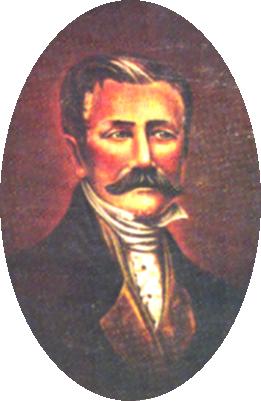
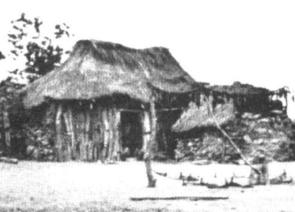 Development Activities
in the New Colony. Houses were constructed as rapidly as possible with
primitive types of architecture prevailing at first. The houses, adobe type, were known as
"jacals" and were only temporary, containing dirt floors and other
inconveniences. Later more pretentious and better houses were built of hand hewn logs.
Development Activities
in the New Colony. Houses were constructed as rapidly as possible with
primitive types of architecture prevailing at first. The houses, adobe type, were known as
"jacals" and were only temporary, containing dirt floors and other
inconveniences. Later more pretentious and better houses were built of hand hewn logs. 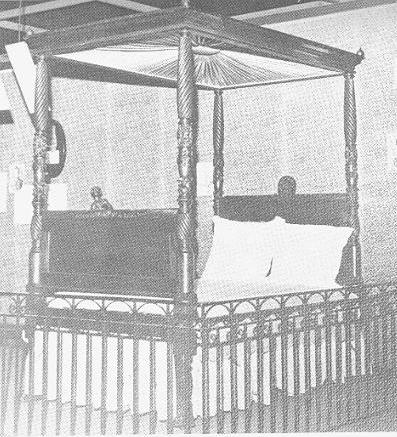
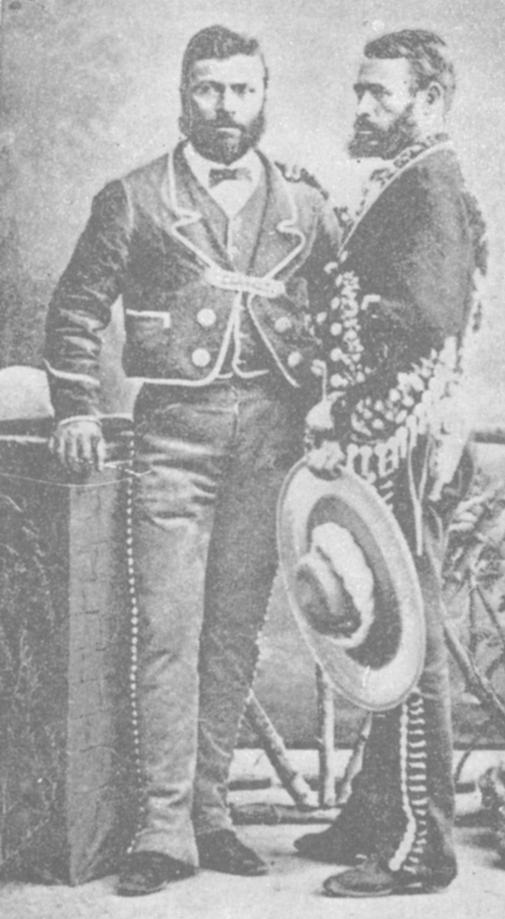
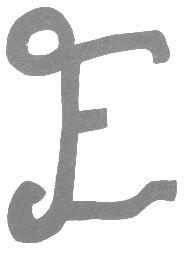 It was on this historical ranch that
thousands of cattle carried the famous brand of Martín De León "E"
"J" connected, which was the first cattle brand in Texas. This famous cattle
brand was used by the Royal De León family of Spain and for hundreds of years earlier,
used by the Jesuit priests. The "E" "J" connected stands for
"Espiritus de Jesus" or "Spirit of Jesus." Don Martín De León
established this famous Texas cattle brand in 1807 and was officially recorded in Texas
and in the Mexican archives in the year of 1807. The branding of the cattle was an
important function at the Empresario's famous cattle ranch. Frequently, they would have a
rodeo or round-up of the cattle. The plan was to have one herding ground on the ranch. The
cattle soon learned to run together at that place. When they saw the "vaqueros,"
on the wing and those on the out skirts started, the movement became general. There was no
prettier site, nor one more interesting, that can be imagined than a rodeo in full
progress. Every cow caught the alarm and they would start off at a brisk trot heading for
the herding ground, not by a circuitous route, but across the hills and valleys and
converging as they proceeded to the point of destination. The largest, wildest and
strongest always took the lead, but they all had the same spirit, with one idea, which was
to get there as soon as possible. The "vaqueros" followed to hurry up the
stragglers and when the round-up was made, whatever may have been the purpose of the drive
whether to cut out and deliver beef cattle, brand cattle or merely take out and doctor
those that had wounds from the blow flies, everyone had a great time. The cattle wanted
were cut out and taken to the pen, and then the herd dissolved itself again scattering
over the prairies and the range. It was a majestic and beautiful sight. The round-up of
the cattle was held in the spring and fall of each year. The various ranchmen in the
colony together with Don Martín's many cowboys (vaqueros) would round up or gather the
loose free ranging cattle or calves.
It was on this historical ranch that
thousands of cattle carried the famous brand of Martín De León "E"
"J" connected, which was the first cattle brand in Texas. This famous cattle
brand was used by the Royal De León family of Spain and for hundreds of years earlier,
used by the Jesuit priests. The "E" "J" connected stands for
"Espiritus de Jesus" or "Spirit of Jesus." Don Martín De León
established this famous Texas cattle brand in 1807 and was officially recorded in Texas
and in the Mexican archives in the year of 1807. The branding of the cattle was an
important function at the Empresario's famous cattle ranch. Frequently, they would have a
rodeo or round-up of the cattle. The plan was to have one herding ground on the ranch. The
cattle soon learned to run together at that place. When they saw the "vaqueros,"
on the wing and those on the out skirts started, the movement became general. There was no
prettier site, nor one more interesting, that can be imagined than a rodeo in full
progress. Every cow caught the alarm and they would start off at a brisk trot heading for
the herding ground, not by a circuitous route, but across the hills and valleys and
converging as they proceeded to the point of destination. The largest, wildest and
strongest always took the lead, but they all had the same spirit, with one idea, which was
to get there as soon as possible. The "vaqueros" followed to hurry up the
stragglers and when the round-up was made, whatever may have been the purpose of the drive
whether to cut out and deliver beef cattle, brand cattle or merely take out and doctor
those that had wounds from the blow flies, everyone had a great time. The cattle wanted
were cut out and taken to the pen, and then the herd dissolved itself again scattering
over the prairies and the range. It was a majestic and beautiful sight. The round-up of
the cattle was held in the spring and fall of each year. The various ranchmen in the
colony together with Don Martín's many cowboys (vaqueros) would round up or gather the
loose free ranging cattle or calves.